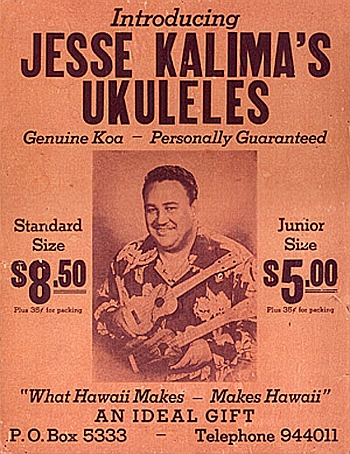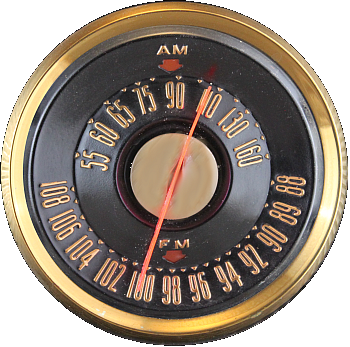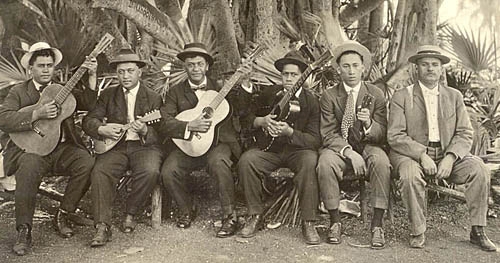When you think of a popular music performer of the 1920s or 1930s, as often as not you may visualize some guy in a coon-skin coat strumming a ukulele. That simple instrument was hugely popular at the time, and then it faded, then came back and faded again. It had a reputation as kind of corny; a novelty instrument not much better than a toy but certain people managed to give it the respectability it deserves and kept it from obscurity.
The ukulele has had another resurgence of popularity recently, and it has more respect this time. Last week we in Orillia were lucky to be able to see a performance by Stuart Fuchs, perhaps the most accomplished ukulele player in the world and he ably demonstrated there is virtually nothing you can’t do on it. As he says in his program, the ukulele is easy to play but hard to master.
The revival has sparked new interest in vintage ukuleles, old recordings and sheet music. The instrument has a unique place in our musical culture and has a fascinating history.
The instrument itself is an odd hybrid and, as far as stringed instruments go, is a fairly recent invention.
We naturally associate the ukulele with Hawaii and that is indeed where it comes from but it is not a traditional Hawaiian, or Polynesian, instrument. It was invented by Portuguese immigrant cabinet makers around 1879 who modeled it after the machete, a small guitar-like instrument popular in their home town of Madeira, Portugal. Originally called the braginho, the locals named it the ukulele, meaning the gift that came here though it is also thought to relate to the Hawaiian phrase for jumping flea because of the frantic strumming action.
 Manuel Nunes is credited with being the inventor though his friends Augusto Dias and Jose do Espirito Santo also played important roles. They made machetes, guitars and ukuleles during the 1890s but by 1910 Nunes was making ukuleles almost exclusively.
Manuel Nunes is credited with being the inventor though his friends Augusto Dias and Jose do Espirito Santo also played important roles. They made machetes, guitars and ukuleles during the 1890s but by 1910 Nunes was making ukuleles almost exclusively.
This was a time when traditional Hawaiian culture was being threatened with extinction by Europeans and the ever-present influence of missionaries who, as we well know in Canada, all too often saw indigenous culture as a problem to be eradicated.
Hawaii was a kingdom at this point, the result of British and foreign meddling. However King David Kalakaua, who reigned from 1874 to 1891, was not a foreign puppet. He was a driving force in the revitalization of traditional Hawaiian culture but also open to modern music and new influences that would enhance that culture. Kalakaua studied and vigorously promoted hula, a dance the missionaries tried to suppress for obvious reasons (to them anyway). He loved playing the ukulele and incorporated it into the traditional dance.
He was successful in reviving Hawaiian culture but the Kingdom was eventually overthrown. The United States stepped into the resulting turmoil and annexed Hawaii in 1898. From then on all eyes on the islands looked towards the mainland.
The newly revived Hawaiian culture was presented stateside at the Panama Pacific International Exhibition in San Francisco in 1915. The Hawaiian Pavilion was organized by ukulele maker Jonah Kumalae and featured the Royal Hawaiian Quartet, an ensemble of guitar and ukulele players. They were a sensation; Kumalae won the gold medal and a craze for all things Hawaiian quickly spread across the U.S. The ukulele was also very popular in Japan and Britain. In the 1960s it became an integral part of music education in Canadian schools so is played more here than in most countries.
Jazz, country and popular performers quickly took to the ukulele, most notably virtuosos Roy Smeck and Cliff Edwards. Smeck could literally play almost anything and had a long career as a performer and instructor. In 1926 he played his ukulele in what may have been the first music video; a short sound film that made him an instant celebrity. Edwards, under his nickname Ukulele Ike, was also a household name. He had a very unusual singing style he called “eefin” that evolved into scat, but he was primarily known in his early career as a ukulele master. He later gained even more fame in the 1940s as the voice of Jiminy Cricket in Walt Disney’s Pinocchio singing the classic When You Wish Upon a Star.
Amateurs also took to the ukulele because it was so easy to play. Most sheet music of the day contained ukulele chord tablature but, once again, that didn’t just happen, it was the result of the work of one woman.
May Sing Breen was the original Ukulele Lady. Born in New York City in 1895, she became a master player and, with her songwriter husband Peter DeRose, had a very popular, long-running radio show in her home city. It was she who convinced the sheet music publishers of the commercial value of adding ukulele arrangements. A tireless teacher and promoter, she also convinced the Musicians Union to classify the ukulele as a legitimate musical instrument.
That has always been the ukulele’s PR problem; people just don’t take it seriously. With just four strings (usually, there are variations) it is easy to just pick up and strum and that’s what most people do. Being able to play the ukulele doesn’t qualify you as a musician in most people’s mind. Breen’s slogan was “Uke can play the melody” and all the master players, starting with the early ones in Hawaii, took great pains to demonstrate this by playing a very wide variety of complicated music. However the ukulele is a very happy sounding instrument and almost no player, no matter how dedicated and serious, can resist adding a humourous element to their performances.
Inevitably the craze faded, the guitar rose to prominence and the ukulele became a bit of a joke. “You play the uke, you’re from Dubuque” went the lyrics of one song chiding a lovers’ less appealing characteristics. It stayed popular with some musicians up to the 1960s, TV entertainer Arthur Godfrey almost single-handedly kept it in the limelight in the 1950s even though he was not a very good player. Then of course there was Tiny Tim who revived Nick Lucas’ 1929 hit Tiptoe Through the Tulips in 1968. Now Tiny Time was an underrated musician, highly respected in musical circles but not taken seriously by the public so infortunately he did nothing to enhance the ukulele’s image.
The current revival has been sparked by groups like the Ukulele Orchestra of Great Britain and helped along by Hawaiian Israel Kamakawiwoʻole's haunting rendition of Somewhere Over the Rainbow/What a Wonderful World which is used extensively in films and commercials (even though he completely messed up the lyrics). Iz, as he was called, believed strongly in Hawaiian independence and saw playing the ukulele as a political statement.
There are now many new ukulele makers and you can buy a plastic one for as little as forty bucks but the classic, early instruments are highly collectable. The most desirable are the Hawaiian koa wood instruments, especially those made by Kumulae, Nunes and Kamaka with the latter, which is still in business, being the king. They can easily reach thousands of dollars in value.
There were many early American makers; most guitar companies including Harmony and Gibson got into the act but of course, the most desirable are those made by legendary guitar make C.F. Martin. For a while, ukuleles were more important to them than guitars. Many of the early stars like Roy Smeck had their own models and they can command quite a premium. Today there are hundreds of variations and sizes including hybrids like the banjolele so the collecting possibilities are endless.
Other than collecting though, the real fun is in playing. Even if you, like me, have no musical talent you could probably learn a song in just a few minutes. From there, the world is your oyster.

